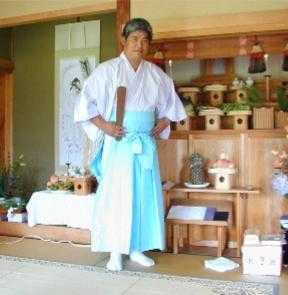袴 - Hakama
In the discussion of clothing for men, we find the “HAKAMA” as far back as the 4th century. At that time, it was like pants tied at the knee and was everyday apparel for the people. We can see the same kind of dress on the statue of Okuninushi no Mikoto at the Taisha Shrine.
男性が着る「袴」の歴史は4世紀にまでさかのぼります。当時の袴は膝のところで結ぶようになっており、普段着として着用されていました。 出雲大社にあるオオクニヌシノミコトの像は、このような衣装を身に着けています。
From the Kamakura Period (1185 – 1333) through the Muromachi Era (1336 – 1573), it changed its style to a type of wide trousers which was worn by Samurai. The nobles wore a similar type of pant-like trousers called, “SASHINUKI” and this is what we often see in movies and exhibits under the misnomer of “HAKAMA.”
鎌倉時代(1185-1333)から室町時代(1336-1573)にかけて、袴は幅の広いズボンのような形に変化し、侍に着用されました。貴族は「さしぬき」と呼ばれる袴に似たズボンのような形のものを履いていましたが、実は今日の映画や展示会などで袴として紹介されているものはこれなのです。
Strangely enough, noble women wore the HAKAMA in the Kamakura Period. Earlier in the Kamakura Era and Heian Era, ceremonial court dress for women was a garment similar to the HAKAMA, called “UCHIKI.” After this time it was not found as common dress among women until the Meiji and Taisho Eras, when girl students began to wear it as a school uniform.
おもしろいことに、鎌倉時代には貴族の女性も袴を着用していました。鎌倉時代初期と平安時代には、女性は宮中での儀式の際、「うちき」と呼ばれる袴に似た衣装を身に着けていました。 以後、女性の普段着としての袴の登場は、女子学生が制服として着用した明治、大正時代を待たねばなりませんでした。
The HAKAMA has about disappeared, except in some formal ceremonies, some types of old stage shows and some sports such as Kyudo, Kendo, etc. Men continued to wear it until it was replaced by modern western dress in the Meiji Era. Women also changed to western dress, more or less, in the Meiji Era. These days, it is very difficult to see the kimono or other old type dress, except as mentioned above – during formal arts, ceremonies and sports.
今日では、特別な儀式、日本古来の演劇、弓道や剣道といったスポーツの場を除いて、袴を見ることはほとんどありません。 男性は、長い間袴を着用していましたが明治時代になると洋服を着るようになりました。女性もほぼ同時期に西洋の服を着るようになりました。現在は上記のような場合を除いて、着物やその他の日本の伝統的な衣装を見かけることはあまりありません。
